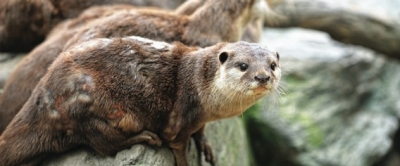The Mystery of the Sea Otter’s Red Coat

By Danielle Ferrante
Sea otters are known for their unique social habits and undeniable charisma. They are also known for their exceptional grooming habits, spending almost half of their day making sure their fur is in perfect condition. It was this fact that made biologist Gena Bentall do a double take when she spotted a male sea otter’s back covered in a red substance.
Her first thought was that it was either crude oil or some type of injury. Whenever an otter’s fur becomes covered with a foreign substance it makes it difficult for them to stay warm. If this happens, the cold seawater could eventually give the otter hypothermia, so grooming their fur is an extremely important task. Bentall rounded up a team of specialists to find out exactly what was covering the animal. It turns out the red coating was actually algae, which surprised Bentall and her team. Their otter’s grooming habits combined with the fact that algae usually grow on rocks puzzled the scientists and forced them to investigate further.
The algae are called Acrochaetium secundatum (AH-kro-KAYT-ee-um Seekum- DAH-tum) and are usually found in the North Atlantic region. The reason algae usually grow on stable surfaces like stones or coral is because they needs a strong surface that cannot be easily moved by the ocean’s current or other marine animals.
So how can the algae survive on a sea otter that is constantly swimming, sliding and combing its fur?
It turns out the red algae only grow at the very end of the otter’s longest hairs, allowing the otter to stay completely warm. This was reassuring news to Bentall and her team. The algae are just looking for a place to live where they can easily reach the nutrient-rich seawater.
While the otters aren’t threatened by red algae, they still face other serious risks such as shark attacks, pollution and disease. Serious efforts have been made toward restoring the levels of sea otter populations, but they are still classified as an endangered species. As long as we continue to research all of the challenges and risks sea otters face, we can be sure they are protected and cared for properly.
Classroom Discussion
- Most algae contain chloroplasts in their cells. What is the chloroplasts’ main function? What other survival risks do sea otters face? Pick one and describe a way to help combat this issue.
Vocabulary
- Algae
- Hypothermia
- Marine Animals

